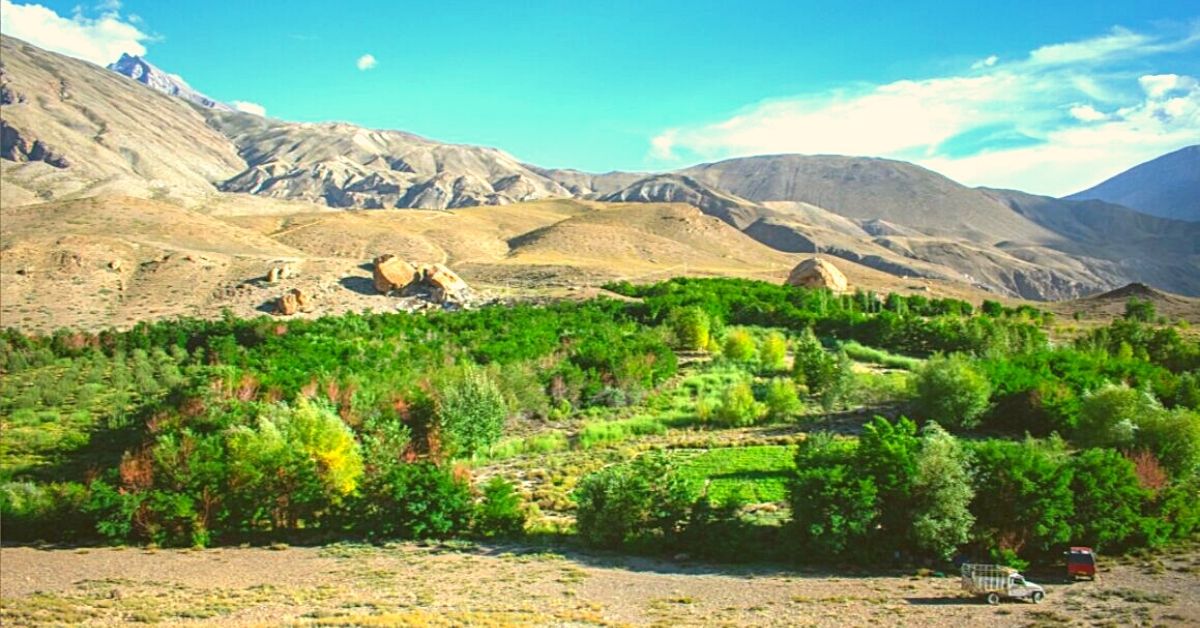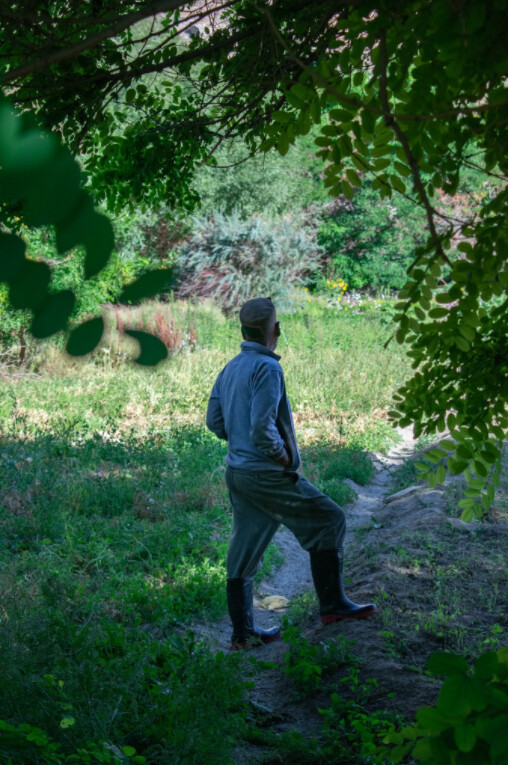The Upper Kinnaur region in Himachal Pradesh is a lot like the cold desert of Ladakh — largely uncultivated and sparsely populated. Vegetation in this cold arid region is limited to grass and shrubs at altitudes of more than 3,200 metres above sea level.
(Above image of AD Negi courtesy Twitter/Pradeep Sangwan)
However, in the midst of this cold desert lies an oasis of lush green forest marked by rubiniya (robinia), willow, poplar, juniper and other coniferous trees in Thang Karma, a very remote village located 50 km uphill from the small town of Pooh in Kinnaur district.
This lush green forest, with over 30,000 trees on 65 hectares of land, was planted and nurtured by the late Anand Dhawaj Negi, a retired bureaucrat who recently passed away at the age of 74 on 23 May 2021 after suffering a serious brain stroke. Besides these trees, his work also enabled the production of potatoes, peas, asparagus, sunflower, mushroom and kidney beans, as well as traditionally grown fruit crops, including apples and apricots.
In the late 1990s, AD Negi was working with the Himachal Pradesh government for its Desert Development Programme (DDP), which sought to mitigate the effects of desertification in these arid regions. While working with the government, he saw crores of taxpayer money go down the drain. As the son of humble farmers, he was frustrated at the inability of the government to generate any fruitful results.
So, in 1998, he began working on this patch of land in Thang Karma as a volunteer and was the first to implement one of the most audacious cold-desert programmes in recent memory. In the following year, he took a leave of absence and by 2003 had put down his papers to work on this project full-time.
“I took permission from the competent authority in 1998 and started working as a volunteer, being a son of the soil. And the success rate is in front of you today,” said AD Negi, in this 2017 interview with Down to Earth.
Finding his way
A native of Sunam village in Kinnaur, Negi was an auditor employed with the finance wing of the Himachal Pradesh government’s desert DDP.
“During his stint there, he discovered this barren patch of desert area in Thang Karma and took stock of the situation. Negi Ji took it upon himself to make this endeavour successful,” says Virender Sappa Negi, his nephew, speaking to The Better India.
In his interview with Down to Earth, Negi talks about how bureaucrats and scientists working in the DDP never took the trouble of spending time on ground and understanding the situation. Himachal Pradesh’s DDP was part of a larger centrally sponsored scheme launched in 1977-78. The objective of the programme was to control the desertification and restoration of ecological balance in desert areas.
Whenever the Comptroller Auditor General of India would ask why DDP never took off, state government officials would cite how they didn’t have the requisite technology to develop plantations in cold deserts. Negi, however, wasn’t buying that line of reasoning. As he recalls in the 2017 interview, “It is only after I spent time experimenting with different kinds of plantations here that I have been able to develop this desert.”

The mantra of consistency
The process of converting this barren patch of forest into a lush green forest began by raising a nursery, following which he developed a site for contour plantation. His initial attempts at sowing seeds failed because the water supply wouldn’t arrive on time. Moreover, without any support from the state, he spent all his savings in the project, where he brought together local practices and scientific methods to develop the 65 hectares.
In the initial months, about 80% of the saplings would wither away in this cold desert. Today, the survival rate is about 99%. So what did he do to achieve this success rate?
He took measures such as contour planting, which is the practice of tilling sloped land along a consistent elevation to conserve rainwater and reduce the loss of soil from surface erosion. To address the problem of irregular water supply, which is dependent on glacier meltwater, he worked with local communities to channel streams from the glaciers situated around 25 kilometres away.
“[The] irrigation department supplies water here. Earlier, it did not make water available before June. I worked on it and supplemented their efforts. I also worked on the Kuhls, so we managed to get water supply in the months of April and May. Once we made it possible, the irrigation department also cooperated and ensured regular water supply here,” said Negi in the 2017 interview.
But what are Kuhls?
According to rainwaterharvesting.org, “Kuhls are a traditional irrigation system in Himachal Pradesh — surface channels diverting water from natural flowing streams (khuds). A typical community kuhl services six to 30 farmers, irrigating an area of about 20 ha. The system consists of a temporary headwall (constructed usually with river boulders) across a khud (ravine) for storage and diversion of the flow through a canal to the fields.”
“Since the soil here has sandy loam, it is better that water flows quickly through the channels. So we made narrow channels and dug them on steeper inclines,” Negi added. He also harvested water “using the traditional system of zings, where channels end in a small pond where glacial melt is collected. These ponds raise the level of humidity in the air and keep groundwater recharged,” notes this 2010 Down to Earth report.
To further retain the water, he planted clovers along these irrigation channels, which also doubles up as a protective cover from hares who destroy crops. Also, their roots decompose every three years, which helps improve the soil’s fertility over a period of time.
The soil in Thang Karma is sandy loam with low nitrogen content. To facilitate the process of nitrogen fixing, he started a farm rearing about 300 Chigu goats. Mixing the waste generated by the Chigu goats and earthworms, he sought to double the nitrogen content in the soil.
Negi was adamant about never employing chemical fertilisers and pesticides, despite scientists who visited the site trying to convince him otherwise. All his farming needs were met by organic compost generated by Chigu goats and he only grew vegetables and fruits that he knew could survive the harsh desert climate and terrain.
“My first priority here is afforestation. Robinia trees are the highest in number. They are followed by willow poplar and wild apricot trees. As far as fruit trees (such apricots and apples) and other crops including green peas are concerned, I grow them just for demonstration purposes so that people can replicate them,” he said. Since then, about 200 farmers have got land from the government, and they have been inspired by Negi to grow their own orchards.
“We have created an asset worth almost Rs 4 crore, mostly from 30,000 trees valued at the government’s rate of Rs 1,000 a tree,” Negi said in the 2010 interview.
Speaking to The Better India, Virender Sappa Negi says, “Before he bade goodbye to us, he was planning to plant some evergreen or coniferous trees like pine and deodar. Now, as a family, we want to fulfill his last wishes. Also, we want the state government to take responsibility for his forest so that his work can inspire future generations.”

Leaving behind a legacy
Today, people from villages nearly 50 km away take their sheep to graze in Thang Karma because the clover he planted there is considered quality fodder. Meanwhile, orchard owners from villages like Chango, which is popular for very sweet apples, would come and buy sackfuls of vermicompost from Negi for about Rs 100 per sack weighing anywhere between 50 and 60 kgs. Also, the nursery which he first built supplies saplings to farmers from nearby villages.
Pradeep Sangwan, the convenor of Healing Himalayas, a non-profit, talks about the last time he met Negi. He recalled inviting Negi for the opening of his non-profit’s first waste collection centre in Kinnaur and another one in Pooh, where the septuagenarian resided in a small room. Although Negi declined the first offer, he accepted the invitation for the inauguration in Pooh, and also invited Sangwan to Thang Karma in June or July, when the forest is lush green, and stay a couple of days. However, commitments in June meant Sangwan and his friends visiting Thang Karma in April.
“We drove down there from Kinnaur. For the first 10 km, there was nothing but barren land and remote border outposts of the Indian military. As you get adjusted to the terrain, you suddenly see this lush green forest-like an oasis in the middle of a desert. There we met the caretaker, whom Negi had gifted 80 goats for his family to rear. Communities from nearby villages started coming down to Thang Karma and building small orchards, particularly apple cultivation, thanks to his work. This was not Negi Uncle’s intent, because he wanted to build this forest for the local wildlife. Today, students from agricultural universities visit the forest every summer and experiment to see whether certain types of plants or crops can grow in that climate. In a way, the forest has become a centre of learning/university,” recalls Sangwan.
Negi spent 22 years in his efforts to turn this cold desert area around, all the while remaining oblivious to his own health and wellbeing.
“We don’t know who or how many people will further his legacy and work, but our organisation may dedicate some of our members to help carry on his work in consultation with his family members and local administration. However, we don’t want others in the region to replicate his project because that would change the entire landscape. If someone started mini-forests in a region like Spiti, the landscape will change drastically and not necessarily for the better. But the odd small forest in a cold desert will not harm the local ecology,” he adds.
Most local farmers who have given up farming and government departments that had once forsaken this land have learnt from him how consistency can change anything. Negi didn’t employ rocket science to build a forest, but what stands out is the consistent hard work that went into it for over two decades. What he did in these parts should be taught in schools.
(Edited by Divya Sethu)
No comments:
Post a Comment